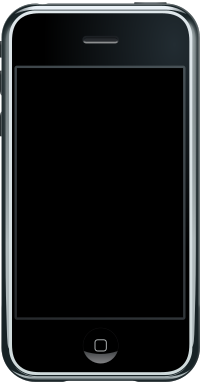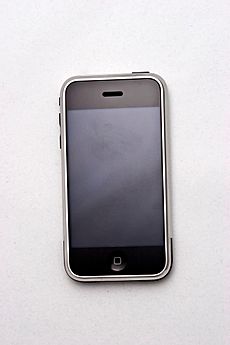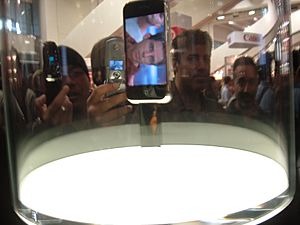- This page was last modified on 17 October 2025, at 10:18. Suggest an edit.
iPhone (1st generation) facts for kids
This page is about the first-generation iPhone. For the product line, see iPhone.
"iPhone 2G" redirects here. For the second-generation iPhone, see iPhone 3G.
 |
|

Front view
|
|
| Developer | Apple Inc. |
|---|---|
| Manufacturer | Foxconn (contract manufacturer) |
| Series | iPhone |
| First released | June 29, 2007 |
| Discontinued | July 15, 2008 |
| Units sold | 6,124,000 |
| Replacement model | iPhone 3G |
| Related | iPad, iPod Touch (comparison) |
| Type | Smartphone |
| Form factor | Slate |
| Size | 115 × 61 × 11.6 mm (4.53 × 2.40 × 0.46 in) |
| Weight | 135 g (4.8 oz) |
| Operating system |
|
| Memory | 128 MB eDRAM |
| Storage | 4, 8, or 16 GB flash memory |
| Battery | 3.7 V 1400 mAh Lithium-ion battery |
| Data inputs |
|
| Screen | |
| Rear camera | 2.0 MP with geotagging (not GPS-based) |
| Sound |
|
| Connectivity |
|
The iPhone (also called the iPhone 2G or iPhone 1) was the very first iPhone model. It was a smartphone made by Apple Inc.. People had been talking about it for years. It was officially announced on January 9, 2007. The phone was then released in the United States on June 29, 2007.
The iPhone changed how mobile phones looked. It got rid of most physical buttons. Instead, it used a special touch screen that you could control with your fingers. This was different from other phones that used a pen-like tool called a stylus. The iPhone had only a few buttons and a large touch screen. It could connect to the internet and use apps that weren't just for making calls. Its next version, the iPhone 3G, came out on June 9, 2008.
The iPhone quickly became a huge success for Apple. Later versions helped Apple become one of the world's most profitable companies. The App Store let people create and sell their own apps. This gave users new ways to get information and connect with others. The iPhone was popular with everyone, not just business people. It used existing technology and made it easier to use. This completely changed the smartphone world.
Contents
History of the First iPhone
Making the iPhone started in 2005. It was a secret project until it was shown to the public at Macworld 2007.
How the iPhone Idea Started
In 2000, Apple's boss, Steve Jobs, had an idea. He wanted to make a touchscreen product that people could use directly with their fingers. At that time, many touchscreens needed a stylus (a special pen). Even Apple's old Newton device, from 1993, used one.
Jobs decided his new device needed a special multi-touch screen. This was a very new and advanced technology. It meant you could use more than one finger at a time. This screen helped get rid of the need for a physical keyboard and mouse.
Jobs asked some Apple engineers to work on this idea as a secret project. When he saw what they made, he realized it could be a mobile phone. He wanted it to compete with other touch screen phones that were starting to appear. This whole project was called "Project Purple 2" and began in 2005.
Working with AT&T
Apple worked secretly with Cingular Wireless (now part of AT&T) to create the iPhone. This project cost about $150 million and took two and a half years. Apple did not want to make a phone by having many different groups design it. They wanted to design the iPhone's hardware and software themselves.
Steve Jobs showed the first iPhone on January 9, 2007. This was at the Macworld Conference & Expo in San Francisco. Jobs said he had been waiting for this day for a long time. He also said that Apple was going to "reinvent the phone." He described the iPhone as three things in one:
- A "widescreen iPod with touch controls."
- A "revolutionary mobile phone."
- A "breakthrough Internet communicator."
The Screen Change
Just six weeks before the iPhone was released, something important happened. Steve Jobs was upset because his keys scratched a test iPhone in his pocket. So, the plastic screen was quickly changed to glass. This led to a fast competition for a company to make the screens. Foxconn won the job. They had just opened a new part of their factory in Shenzhen especially for this project.
iPhone Release and Sales
Many Americans knew the iPhone was coming before it was released. The iPhone came out in the United States on June 29, 2007. It cost $499 for the 4 GB model and $599 for the 8 GB model. Both needed a 2-year phone contract.
Thousands of people waited outside Apple and AT&T stores for days before the launch. Many stores sold out of iPhones within an hour.
Sales in Europe began in November 2007. It was first sold in Germany, then Britain, and then France. These launches were not as busy as the one in the US. In France, the phone was sold by Orange for 649 euros. The iPhone was also released in Austria and Ireland on March 13, 2008.
The original iPhone was not released in Canada. Instead, the iPhone 3G was brought to the Canadian market later.
iPhone Hardware Features
Outside of the iPhone
The back of the first iPhone was made of aluminum, which is a soft metal. The screen was an LCD screen. It had a resolution of 320x480 pixels and measured about 3.5 inches diagonally. This was much bigger than most other phones at the time. The iPhone was also the first mobile phone with multi-touch technology.
The camera on the back of the iPhone had 2 megapixels. It could also add location information to photos, which is called geotagging.
The iPhone had four buttons and one switch:
- A power and sleep button.
- Volume up and volume down buttons.
- A silent/ringer switch.
- A home button at the bottom center of the phone's front. Pressing the home button would take you back to the main screen.
Inside the iPhone
The iPhone had a Samsung microprocessor. It was slowed down from 620 MHz to 412 MHz to make the battery last longer. It also had a special graphics chip called PowerVR MBX Lite 3D.
The iPhone also included several sensors:
- An accelerometer: This senses how the phone is moving or tilting.
- A proximity sensor: This turns off the screen when you hold the phone to your ear.
- An ambient light sensor: This adjusts the screen brightness based on the light around you.
Like the iPod Touch, the iPhone had a 3.5 millimeter headphone jack. The phone also had a 3.7 V 1400 mAh lithium-ion battery built inside.
iPhone Software
When Steve Jobs first showed the iPhone, he said it ran "OS X" and "desktop-class applications." But when the iPhone was released, its operating system was called "iPhone OS."
The first iPhone supported three main versions of its operating system before it was stopped: iPhone OS 1, 2, and 3. The last update for the original iPhone was iPhone OS 3.1.3.
Software History and Updates
The first operating system for the original iPhone was iPhone OS 1. It had many features:
- Visual Voicemail: You could see a list of your voicemails.
- Multi-touch gestures: You could use multiple fingers to control the screen.
- HTML email: Emails looked like they do on a computer.
- Apple's Safari web browser.
- Threaded text messaging: Messages were grouped by contact.
- An "iPod" app for music and videos.
- A special YouTube app.
- A Maps app powered by Google Maps.
It also had basic apps like Phone/contacts, Calendar, Photos, Stocks, Weather, Clock, Calculator, Notes, and Settings.
However, some features were missing at first. These included MMS (for sending pictures in texts), apps from other companies, and copy and paste. People would sometimes "jailbreak" their phones to add these missing features. Apple later added these features through software updates.
In September 2007, an update (v1.1) came out with the iPod Touch. This update added an iTunes Store app, which was the first new app added to the system.
iPhone OS 2 was released on July 11, 2008, when the iPhone 3G came out. This update brought the App Store. This meant you could download apps made by other companies. It also added support for Microsoft Exchange (for work emails) and push e-mail.
iPhone OS 3 was released on June 17, 2009, along with the iPhone 3GS. This update added the much-wanted copy and paste feature. It also brought Spotlight search to the main screen and new features for the YouTube app. iPhone OS 3 worked on the original iPhone, iPhone 3G, and 3GS. However, some features, like MMS, did not work on the original iPhone.
iPhone OS 3.1.3 was the last software version released for the original iPhone in February 2010. After iOS 6 came out in late 2012, most new apps no longer worked on the original iPhone. This is because the software tools changed and no longer supported older iPhones.
See also
 In Spanish: IPhone (1.ª generación) para niños
In Spanish: IPhone (1.ª generación) para niños


